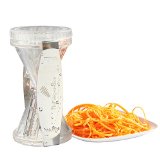Coriander is a plant that is very versatile to use in the kitchen. The leaves (referred to as Cilantro in the US) are delicious as a fresh herb, while the seeds, when freshly ground, add a beautiful aromatic flavour to savoury meals. For those on a Nutritionhelp yeast-free programme and needing to avoid hot spices, this seed is especially helpful as it provides mild seasoning, rather than the fiery taste of chilli and cayenne.
The green leaf is used in Indian cooking, being added at the last minute to increase colour and nutrient value to meals. When I was in India a few years ago I was introduced to fragrant coriander chutney (nothing like an English chutney!), which really is a zing for the taste-buds, and is great spread (thinly) on gluten-free buckwheat crackers or adding a couple of small ‘dobs’ on top of salad.
To make a quick coriander chutney wash 1 cup of fresh coriander leaves and place in a food processor with 1/2 inch of chopped fresh ginger, 1 or 2 teaspoons of lemon juice, and 1/2 teaspoon of cumin powder. Recipes usually call for some salt, but add a very little Lo-Salt or Himalayan pink salt at the end if necessary. Blend all the ingredients, adding a few drops of water to make a smooth consistency. Check seasoning and add a little more lemon juice if required. Store in the fridge for a couple of days. That’s it!
Coriander contains some valuable nutrients which may benefit health. I have sometimes encouraged clients to increase coriander leaf in their diet to help support detoxification. While research on the effectiveness of this approach is not conclusive, it is an easy and tasty addition to the diet, so well worth trying. Danica Collins writes at Underground Health Reporter:
The leaves of the coriander plant possess remarkable detoxifying abilities. Studies have shown that cilantro binds to heavy metals in the bloodstream, thereby purifying tissues, organs, and blood. Cilantro is able to attach to metals due to its biochemical content, including citric acid, phytic acid, and amphoteric electrolytes. And then there are the added benefits of a cilantro cleanse: cilantro helps improve digestion and guards against the onslaught of free radicals that hasten aging and promote disease. A recent study showed that cilantro even purifies water!
Dr Mercola comments on some of the health benefits of coriander in a recent blog post – What is Coriander Good For?
Coriander Seeds Contain Powerful Antioxidants and Have Anxiety-Reducing Effects
Coriander seeds and herbs have been actively investigated for their beneficial properties, including antimicrobial, antioxidant, hypoglycemic, hypolipidemic, anxiolytic, analgesic, anti-inflammatory, anticonvulsant and anti-cancer activities, among others.3
In one study of eight herbs, coriander (as well as basil) contained the highest levels of beta-carotene, beta-cryptoxanthin, and beneficial lutein and zeaxanthin.4
Coriander seed oil also contains up to 70 percent linalool, a terpenoid that has powerful cellular antioxidant properties and is responsible for coriander’s pleasant smell.5
Linalool also has sedative and anxiety-reducing properties, which explains why the seeds have also been valued for treating mild anxiety and insomnia.
Cilantro: Powerful Antioxidant and Anti-Inflammatory Benefits
The leaves are also a treasure trove of beneficial flavonoids, polyphenols and phenolic acids. This includes antioxidant and anti-inflammatory kaempferol and quercetin. Quercetin is an antioxidant that many believe prevent histamine release — making quercetin-rich foods “natural antihistamines.”
Kaempferol, meanwhile, may help fight cancer and lower your risk of chronic diseases including heart disease. The phenolic acids and other nutrients in cilantro are equally impressive. As noted by ABC:8
“These secondary plant metabolites have attracted interest and study for their potential protective role against oxidative damage and its associated diseases, including coronary heart disease, stroke, and cancers.
The leaves of the plant are high in vitamins A, K, and C, as well as calcium.”
Cilantro leaves may also help reduce pain in people with arthritis, a benefit attributed to the vitamins A and C, phenolic acids and polyphenols they contain. One phenolic component, ethanolic extract, was also shown to protect against liver damage in an animal study.9
For the full article and foot notes see this link



